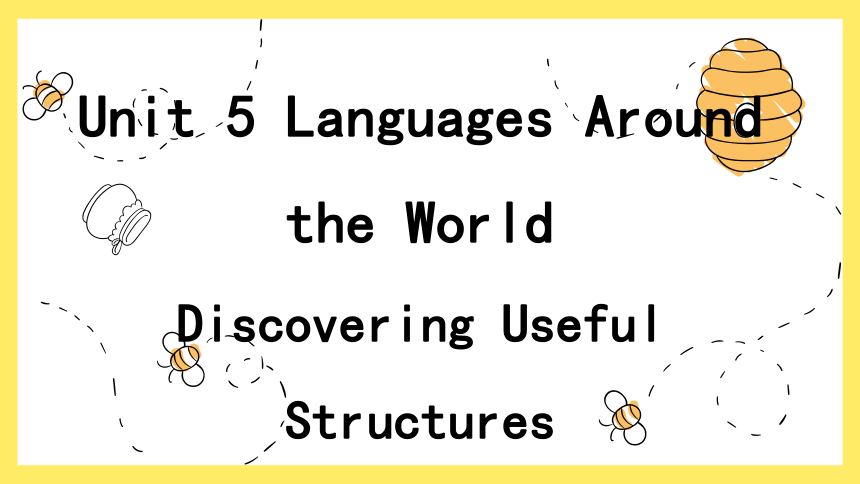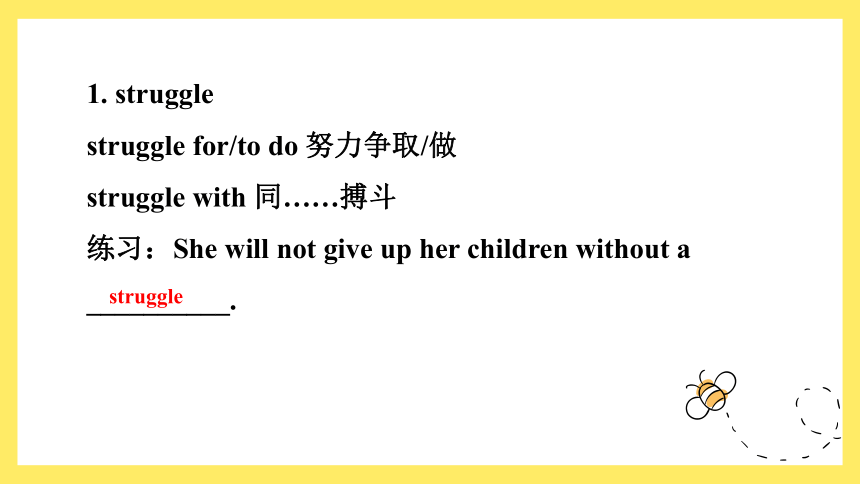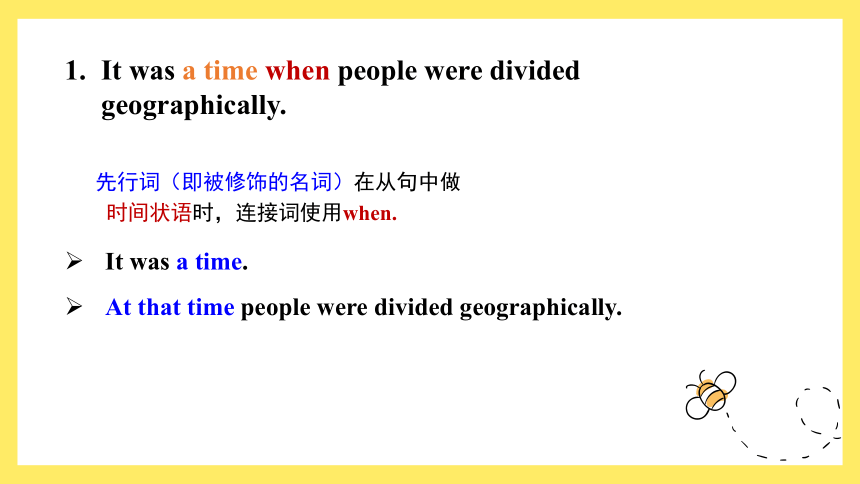人教版(2019)必修第一册Unit 5 Languages Around the World Discovering Useful Structures 课件(共20张PPT)
文档属性
| 名称 | 人教版(2019)必修第一册Unit 5 Languages Around the World Discovering Useful Structures 课件(共20张PPT) |  | |
| 格式 | pptx | ||
| 文件大小 | 869.8KB | ||
| 资源类型 | 教案 | ||
| 版本资源 | 人教版(2019) | ||
| 科目 | 英语 | ||
| 更新时间 | 2023-12-28 18:27:01 | ||
图片预览









文档简介
(共20张PPT)
Unit 5 Languages Around the World
Discovering Useful Structures
Vocabulary
1. struggle
struggle for/to do 努力争取/做
struggle with 同……搏斗
练习:She will not give up her children without a __________.
struggle
2. tongue
put/stick out one's tongue 伸出舌头
one’mother/native language 母语
a sharp tongue 说话尖刻
练习:The dog's _________ was hanging out.
tongue
3. give up
give out:发出,分发,用完,耗尽。
give up:放弃,停止,投降,抛弃。
give over:交托,放弃,停止,移交。
练习:There comes a point where you _________.
give up
Lead-in
Underline the restrictive attributive clauses.
What kind of information does each clause communicate
It was a time when people were divided geographically.
Information: a time for an event.
2. Emperor Qinshihuang united the seven major states into
one unified country where the Chinese writing system began
to develop in one direction.
Information: a location for an event.
3. There are many reasons why people learn a foreign language.
Information: a reason for an action.
4. These were animal bones and shells on which symbols were
carved by ancient Chinese people.
Information: a location for an action.
It was a time when people were divided geographically.
先行词(即被修饰的名词)在从句中做
时间状语时,连接词使用when.
It was a time.
At that time people were divided geographically.
2. Emperor Qinshihuang united the seven major
states into one unified country where the Chinese
writing system began to develop in one direction.
先行词(即被修饰的名词)在从句中做地点状语时,连接词使用where.
Emperor Qinshihuang united the seven major states into one unified country.
In that country the Chinese writing system began to develop in one direction.
3. There are many reasons why people learn a
foreign language.
先行词(即被修饰的名词)在从句中做原因状语时,连接词使用why。
There are many reasons.
Because of these reasons, people learn a foreign language.
4. These were animal bones and shells on which
symbols were carved by ancient Chinese people.
先行词指物且在从句中做状语时,连接词可以用介词+which来替换关系副词,其中介词的选择和先行词的搭配有关。
There were animals bones and shells.
Symbols were carved by ancient Chinese people on them.
These were animal bones and shells on which(=where)
symbols were carved by ancient Chinese people.
介词+which (如on which)的结构一般限于比较正式的文体中。
定语从句(Ⅱ)关系副词的用法
当引导定语从句的关系词在从句中用作时间、地点、原因状语时,应使用关系副词when, where, why或“介词+which”。
关系副词的作用如下:
1.指代表示时间、地点、原因的先行词。
2.在从句中充当句子成分——状语,即在从句中起副词的作用。
3.起连接作用,把主句和定语从句连接起来构成主从复合句。
一、关系副词引导定语从句
1.when引导定语从句
when表示时间,代替先行词并在定语从句中做时间状语,其先行词往往是表示时间的名词,如time, day, year, month, week等。
2.where引导定语从句
where表示地点, 代替先行词并在定语从句中做地点状语,其先行词往往是具体地点place, room, mountain, airport或抽象地点的名词如case, state, condition, point, situation等。
3.why引导定语从句的用法
why表示原因, 代替先行词并在定语从句中做原因状语,其先行词是表示理由的名词reason。
二、关系代词与关系副词的选用
定语从句的引导词用关系代词还是关系副词可以用以下两种方式判断:
用法 依据
根据从句的谓语动词 是及物动词,后面若无宾语,用关系代词;是不及物动词则用关系副词
根据先行词在从句中所作的成分 把先行词代入定语从句中,若作主语或宾语用关系代词;作状语则用关系副词
三、介词+关系代词引导的定语从句
关系副词when, where, why引导定语从句时,关系副词也可用“介词+关系代词“代替。
(1)when可以换成“介词+which”。
(2)where可以换成“介词+which”。
(3)why可以用for which来代替。
1、介词选择的三原则:一先二动三意义。
一先:根据先行词的搭配习惯来确定。
二动:根据从句中谓语动词的搭配习惯来确定。
三意义:根据从句所表达的意义来确定。
2、介词可以后移,此时关系代词可以忽略。
3、名词/代词/数词+of+关系代词 引导的定语从句通常是非限制性定语从句,该结构在定语从句中一般作主语。
Finish the exercises
1. I will always remember the time ________ we lived together.
2. I will always remember the time ________we spent together
3. Can you still think of the village ________ he once worked
4. Can you still think of the village ________he once visited
5. This is the reason________ he explained to me.
6. This is the reason ________ he didn’t come.
when
which/that/省略
where
which/that/省略
which/that/省略
why
Thank you
Unit 5 Languages Around the World
Discovering Useful Structures
Vocabulary
1. struggle
struggle for/to do 努力争取/做
struggle with 同……搏斗
练习:She will not give up her children without a __________.
struggle
2. tongue
put/stick out one's tongue 伸出舌头
one’mother/native language 母语
a sharp tongue 说话尖刻
练习:The dog's _________ was hanging out.
tongue
3. give up
give out:发出,分发,用完,耗尽。
give up:放弃,停止,投降,抛弃。
give over:交托,放弃,停止,移交。
练习:There comes a point where you _________.
give up
Lead-in
Underline the restrictive attributive clauses.
What kind of information does each clause communicate
It was a time when people were divided geographically.
Information: a time for an event.
2. Emperor Qinshihuang united the seven major states into
one unified country where the Chinese writing system began
to develop in one direction.
Information: a location for an event.
3. There are many reasons why people learn a foreign language.
Information: a reason for an action.
4. These were animal bones and shells on which symbols were
carved by ancient Chinese people.
Information: a location for an action.
It was a time when people were divided geographically.
先行词(即被修饰的名词)在从句中做
时间状语时,连接词使用when.
It was a time.
At that time people were divided geographically.
2. Emperor Qinshihuang united the seven major
states into one unified country where the Chinese
writing system began to develop in one direction.
先行词(即被修饰的名词)在从句中做地点状语时,连接词使用where.
Emperor Qinshihuang united the seven major states into one unified country.
In that country the Chinese writing system began to develop in one direction.
3. There are many reasons why people learn a
foreign language.
先行词(即被修饰的名词)在从句中做原因状语时,连接词使用why。
There are many reasons.
Because of these reasons, people learn a foreign language.
4. These were animal bones and shells on which
symbols were carved by ancient Chinese people.
先行词指物且在从句中做状语时,连接词可以用介词+which来替换关系副词,其中介词的选择和先行词的搭配有关。
There were animals bones and shells.
Symbols were carved by ancient Chinese people on them.
These were animal bones and shells on which(=where)
symbols were carved by ancient Chinese people.
介词+which (如on which)的结构一般限于比较正式的文体中。
定语从句(Ⅱ)关系副词的用法
当引导定语从句的关系词在从句中用作时间、地点、原因状语时,应使用关系副词when, where, why或“介词+which”。
关系副词的作用如下:
1.指代表示时间、地点、原因的先行词。
2.在从句中充当句子成分——状语,即在从句中起副词的作用。
3.起连接作用,把主句和定语从句连接起来构成主从复合句。
一、关系副词引导定语从句
1.when引导定语从句
when表示时间,代替先行词并在定语从句中做时间状语,其先行词往往是表示时间的名词,如time, day, year, month, week等。
2.where引导定语从句
where表示地点, 代替先行词并在定语从句中做地点状语,其先行词往往是具体地点place, room, mountain, airport或抽象地点的名词如case, state, condition, point, situation等。
3.why引导定语从句的用法
why表示原因, 代替先行词并在定语从句中做原因状语,其先行词是表示理由的名词reason。
二、关系代词与关系副词的选用
定语从句的引导词用关系代词还是关系副词可以用以下两种方式判断:
用法 依据
根据从句的谓语动词 是及物动词,后面若无宾语,用关系代词;是不及物动词则用关系副词
根据先行词在从句中所作的成分 把先行词代入定语从句中,若作主语或宾语用关系代词;作状语则用关系副词
三、介词+关系代词引导的定语从句
关系副词when, where, why引导定语从句时,关系副词也可用“介词+关系代词“代替。
(1)when可以换成“介词+which”。
(2)where可以换成“介词+which”。
(3)why可以用for which来代替。
1、介词选择的三原则:一先二动三意义。
一先:根据先行词的搭配习惯来确定。
二动:根据从句中谓语动词的搭配习惯来确定。
三意义:根据从句所表达的意义来确定。
2、介词可以后移,此时关系代词可以忽略。
3、名词/代词/数词+of+关系代词 引导的定语从句通常是非限制性定语从句,该结构在定语从句中一般作主语。
Finish the exercises
1. I will always remember the time ________ we lived together.
2. I will always remember the time ________we spent together
3. Can you still think of the village ________ he once worked
4. Can you still think of the village ________he once visited
5. This is the reason________ he explained to me.
6. This is the reason ________ he didn’t come.
when
which/that/省略
where
which/that/省略
which/that/省略
why
Thank you
